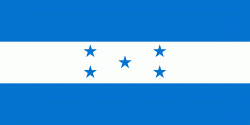Cortés Department (Departamento de Cortés)
Cortés is one of the 18 departments of Honduras. The department covers an area of 3,954 km² and, in 2015, had an estimated population of 1,612,762, making it the most populous in Honduras. The Merendón Mountains rise in western Cortés, but the department is mostly a tropical lowland, the Sula Valley, crossed by the Ulúa and Chamelecon rivers.
It was created in 1893 from parts of the departments of Santa Bárbara and Yoro. The departmental capital is San Pedro Sula. Main cities also include Choloma, La Lima, Villanueva, and the sea ports of Puerto Cortés and Omoa. The Atlantic coast of the Department of Cortés is known for its many excellent beaches.
Cortés is the economic heartland of Honduras, as the Sula Valley is the country's main agricultural and industrial region. US banana companies arrived in the area in the late 19th century, and established vast plantations, as well as infrastructure to ship the fruit to the United States. San Pedro Sula attracted substantial numbers of European, Central American, and Palestinian and Lebanese immigrants. Industry flourishes in the department, and Cortés today hosts most of the country's assembly plants, known as maquilas.
* 1) Choloma
* 2) La Lima
* 3) Omoa
* 4) Pimienta
* 5) Potrerillos
* 6) Puerto Cortés
* 7) San Antonio de Cortés
It was created in 1893 from parts of the departments of Santa Bárbara and Yoro. The departmental capital is San Pedro Sula. Main cities also include Choloma, La Lima, Villanueva, and the sea ports of Puerto Cortés and Omoa. The Atlantic coast of the Department of Cortés is known for its many excellent beaches.
Cortés is the economic heartland of Honduras, as the Sula Valley is the country's main agricultural and industrial region. US banana companies arrived in the area in the late 19th century, and established vast plantations, as well as infrastructure to ship the fruit to the United States. San Pedro Sula attracted substantial numbers of European, Central American, and Palestinian and Lebanese immigrants. Industry flourishes in the department, and Cortés today hosts most of the country's assembly plants, known as maquilas.
* 1) Choloma
* 2) La Lima
* 3) Omoa
* 4) Pimienta
* 5) Potrerillos
* 6) Puerto Cortés
* 7) San Antonio de Cortés
Map - Cortés Department (Departamento de Cortés)
Map
Country - Honduras
 |
 |
| Flag of Honduras | |
Honduras was home to several important Mesoamerican cultures, most notably the Maya, before the Spanish colonization in the sixteenth century. The Spanish introduced Catholicism and the now predominant Spanish language, along with numerous customs that have blended with the indigenous culture. Honduras became independent in 1821 and has since been a republic, although it has consistently endured much social strife and political instability, and remains one of the poorest countries in the Western Hemisphere. In 1960, the northern part of what was the Mosquito Coast was transferred from Nicaragua to Honduras by the International Court of Justice.
Currency / Language
| ISO | Currency | Symbol | Significant figures |
|---|---|---|---|
| HNL | Honduran lempira | L | 2 |
| ISO | Language |
|---|---|
| ES | Spanish language |

















